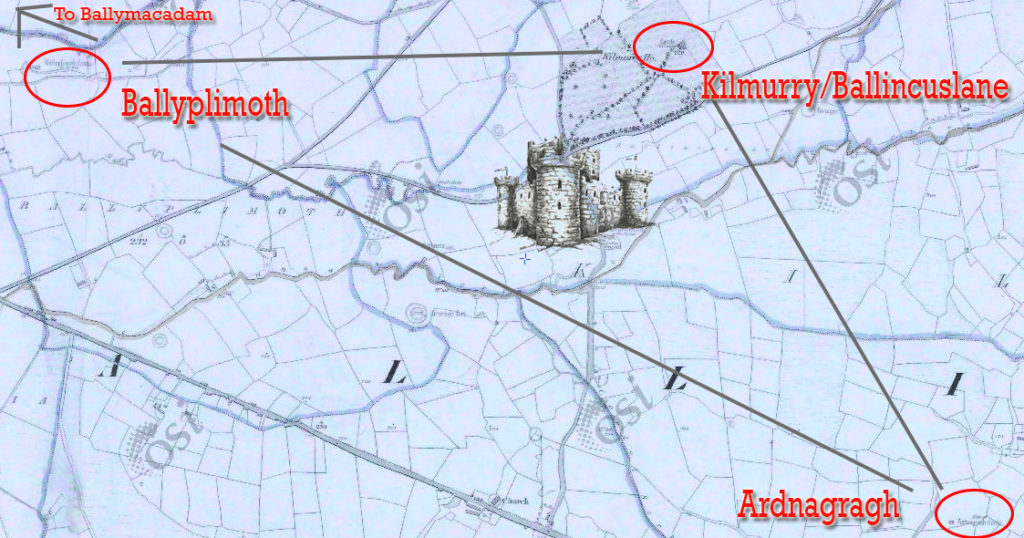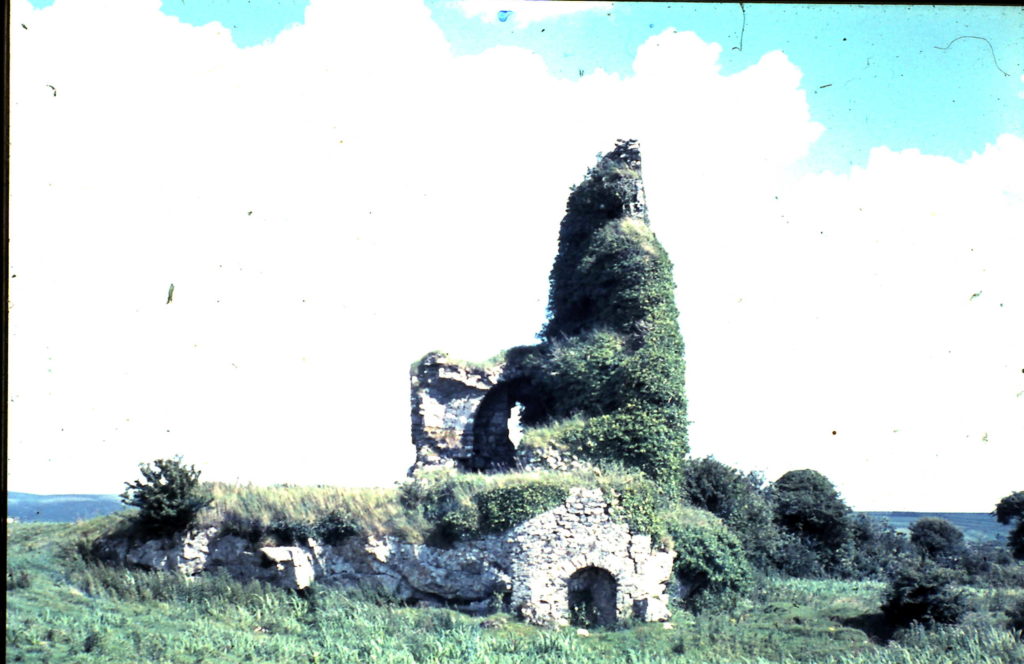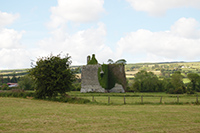In the 1930s, a contributor to the Schools’ Collection described the three castles in Cordal:
There is one in Ard na gCreach, one in Kilmurry and one in Ballyplymoth. They were built by the Fitzgeralds, a great Geraldine family. At first four brothers of them lived together in the castle at Ard na gCreach. They did not agree so well. That is why the other castles were built.1

The same tale was recorded by Historian Charles Smith about two hundred years earlier, who observed that the three castles appeared to have been possessed by three brothers of Fitzgerald ‘who bore so great an enmity to each other that no one of them would suffer the other to pass peaceably through his land.’ 2
Historian Jeremiah King traced the descent of the Fitzgeralds of Ard na gCreach to a younger brother of the first White Knight, Knight of Glin.3 He recorded how David Fitzgerald of ‘Ardnagraph’ had three sons, one of Kilcushnaun, Thomas of ‘Ardnagragh’, and a third son attainted.4
In the late sixteenth century, the Fitzgerald lands were granted to Sir William Herbert, who wrote:
1589, May 24
There was dwelling upon those lands which are now come into my possession a gentleman of the Geraldines, called Thomas Oge, who was committed to the castle of Dublin by Sir John Perrott. I met him in Cork on coming over from England and found him to be a man, sensible, modest, and tractable and so hoped he might be made a good man. By my entreaties I got him released and brought him into the country with me, where by persuasions used unto him he reformed himself in religion, in manners, in habit … Sir Edward Denny to frustrate my endeavours in those parts has got an order from Dublin for his arrest.5
“Three clumps of the walls lie at the site”
In the nineteenth century, the Ordnance Survey’s John O’Donovan observed that Ard na gCreach – ‘the Hill or Height of the Plunders’ – had been totally demolished, ‘three clumps of the walls lie at the site’.6
O’Donovan found the ruin at Ballyplimith more intact, where the north side of the structure was washed by a river and the entrance was formed on the east side:
The north wall of the castle stands on the very extremity over the river. The exterior parts of the walls exhibit a structure of square blocks of stones laid in very regular courses. On the interior are the remains of a stone arch on north and west walls. The north wall and the north-south angle retain their original height, about 50 feet. There were four stories in the building … under the arch on west wall are two windows, the lower one of which is narrow and square, the upper one large and square each lighted a floor on this side. 7
The Ballyplimoth ruin proved a suitable venue for a Castleisland Steeple Chase which took place in 1858:
From the plateau on which the ruin stands an excellent view of the course was obtained. A capital stand too was erected which overlooked the whole arena … weather was beautiful the first day and the ground in excellent order. The second day however was frequent showers and the course was in consequence rather ‘greasy’. 8

In Kilmurry, Ballincuslane, a most impressive ruin still stands tall and commanding on the landscape.9 O’Donovan provided a verbal reconstruction of the building:
The whole consisted of three divisions, court, and two castles, of which, one was attached to the east end of the court and the other ran collaterally from the south side wall being attached to it. The west wall of the castle at east-end is destroyed but traces of it are seen on the interior of the ruin. Length of the ruin … including court and castle is 48 feet.10
Historians record that Kilmurry Castle was taken by Colonel Phaire, Governor of Cork, in August 1650. A legend of this period tells how Patrick Fitzgerald of Kilmurry, youngest and bravest of four brothers, defended his castle and saved his lover, Eva, daughter of Walter O’Connor of nearby Ballymacadam Castle, from death. 11

Not even a few ivy-clad stones remain of Ballymacadam Castle. Within its walls Mary, daughter of Maurice Fitzgerald, was born. Mary married into the family of Marshall, and, a few centuries or so on (1772), the Lord Chancellor appointed Richard Marshall of Ballymacadam one of his Majesty’s Justices of the Peace.12
As the remaining ruins fall into an ever reducing pile, their security rests ever more heavily on the historian.
_______________________
1 The contributor added: ‘One of the brothers was so much afraid of the owners of Ballyplymoth Castle that when going to Castleisland he always had to go round Scartaglin. This meant that he had to go three miles out of his way to avoid unpleasantness and quarrelling. This journey is known locally as Comgar Taidg Chaoic go dtí an Oileán. At one time the Fitzgeralds attacked the O’Keefes of Cork during the night and carried off their cattle. The O’Keefes pursued them hotly and met them at a townland in Cordal called Ard na gCreach. A fierce battle ensued the result of which was that the O’Keefes recovered their cattle and went home triumphant. The townland in which the battle was fought is called Ard na gCreach’ (The Schools’ Collection, Volume 0449, pp6-7). The fourth brother appears to have resided in the Castle in Castleisland town. 2 The Antient and Present State of the County of Kerry (1756), p170. 3 ‘They are called the Sliocht (Slught) Shane, out of them the septs of Maurice Duffe and Slught Edmund in Kerrie’. 4 ‘Thomas of Ardnagragh married having two daughters and a son. 31 May 1587, the castle called Ardnagragh late Thomas FitzDavid Geralds, with the castle and lands of Kilcosteny, and certain other lands of … the late Mac Shane … were granted to Sir William Herbert with Castleisland district.’ 5 King’s History, ‘Fitzgerald Knight of Kerry’ (1915). 6 Ordnance Survey Letters, parish of Ballincuslane, pp498-509. The castle site is at Cordal East townland, close to the ruined Kilnananima Church. Variations of Ardnagragh include Ardnacrah, Ardnagraph, Ardnegragh, Ardnygraghe, Ardnagrah, Ardnegraughe. 7 Ordnance Survey Letters, parish of Ballincuslane, pp498-509. ‘On north wall is one window under the arch, narrow outside, built of coarsely chiselled stone. It is a rude stone arch inside which was circular. Above the arch is another window now injured. It appears to have been square outside … it appears the doorway was on east wall at south east corner.’ Variations of Ballyplimoth include Baile Plimot, Baile Phliomot, Balliphimolt, Baile Plimmoth, Ballyplimmoth, Ballyplimoth, Ballyplymouth, Bally Plymouth (Ballyplimoth townland). In the seventeenth century, 37-year-old Charles Deorane was recorded at Ballyplimoth, having as his parishes Ballincushlane and Castleisland. He received Holy Orders in 1691 from the Bishop of Cassel (ref: ‘The priests of Kerry Two Hundred Years Ago’, Kerry Sentinel, 24 October 1891). S Divane & Sons Calendar of 1999 included an image of the remains of Ballyplymouth Castle ‘which date back to 1420’. 8 Cork Examiner, 14 April 1858. Names of the horses raced included Mr O’Connell’s May Morning, Mr Donovan’s Little Arthur, Mr Eager’s Fly-trap, Mr Bourke’s Wild Girl, Mr Nash’s Jerry, Mr Rae’s The Warrior, Mr Hurly’s Red Robin, Mr Curtayne’s Fortune Hunter, Mr Cotter’s Mountain Witch, Captain Burke’s Old Screw and Mr O’Grady’s Nameless. On the evening of the first day’s race, there was an ordinary at Mrs Knights Crown Hotel for a ‘first-rate dinner’. It was also mentioned that a man named Reidy ‘Beenough’ was thrown that day while schooling a horse for Mr Harnett of Abbeyfeale and died about an hour later. 9 Kilmurry townland, parish of Ballincuslane. Baile an Chaisleain or Baile an Caisleain ‘the town of the castle’. ‘Baile Caisleain is a subdivision of the townland of Kilmurry. Lord Raymond who lived in Kilmurry House and in whose immediate property was Kilmurry Castle took eight acres of land from each of his neighbouring tenants. The land thus grabbed constituted a new townland called Baile an Caisleain’ (The Schools’ Collection, Volume 0449, Page 089). Variations include Ballencastelan, Ballicaslane, Ballycasslane, Ballincaslane, Ballincaslan, Ballycushlaan, Ballincushlane, Ballycushlane. 10 Ordnance Survey Letters, parish of Ballincuslane, pp498-509. 11 ‘A Daring Deed’ by Edmond Loughlin, Weekly Irish Times, 8 August 1896. Retold in Fitzmaurice of Kerry A 17th Century Tale of Kilmurry Castle and Ballymacadam Castle (2018). 12 Kerry Champion, 12 December 1936. Ballymacadam Castle was blasted about twenty years or so ago to make way for a quarry


